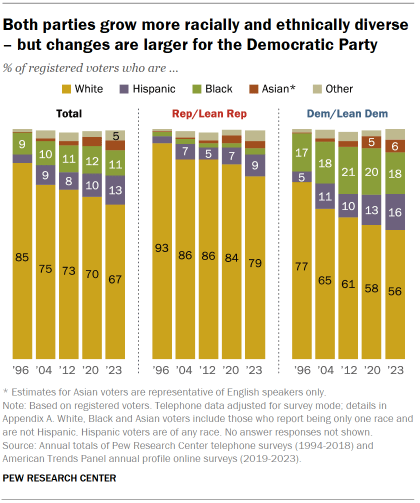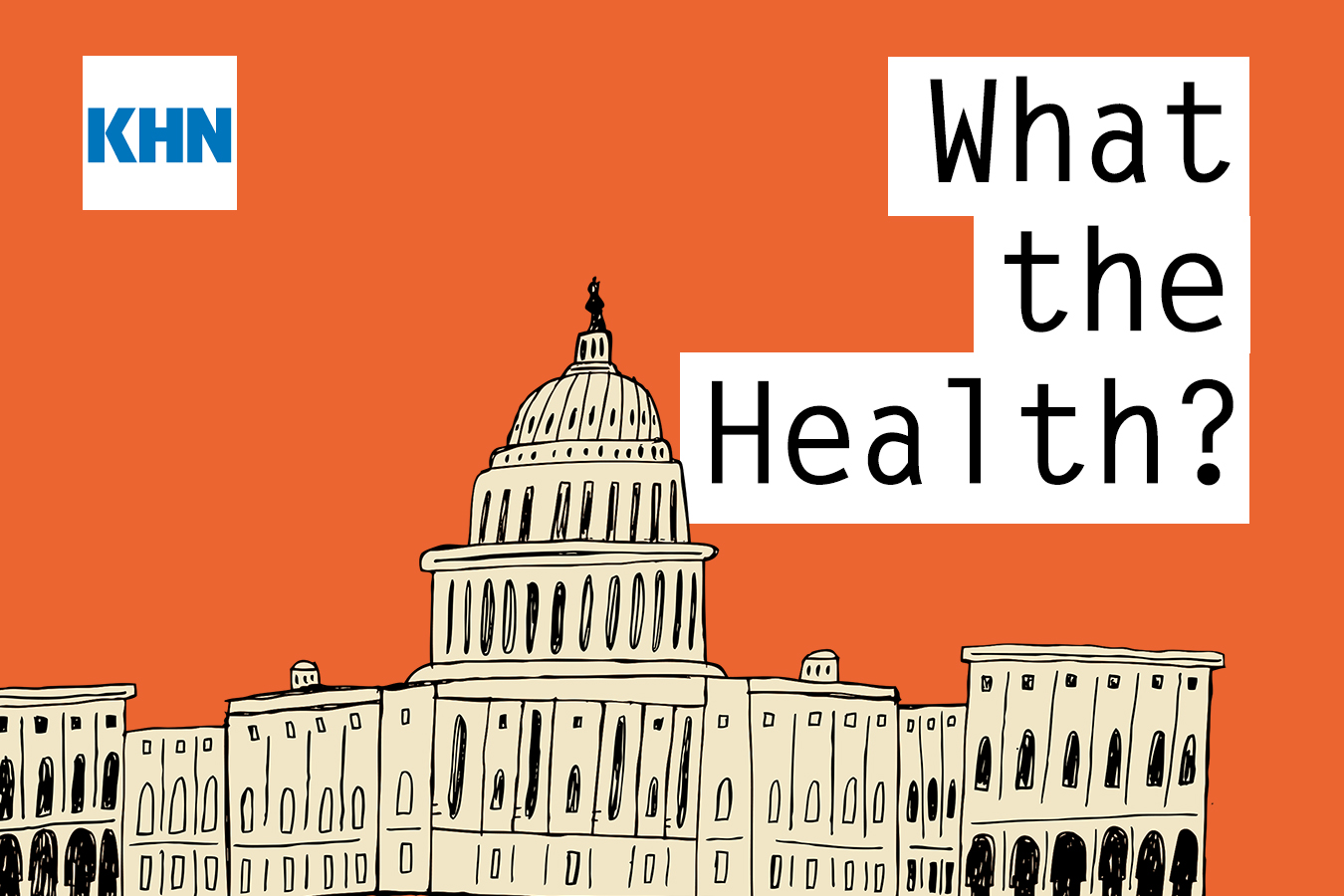Mirroring changes in the U.S. population overall, registered voters have become more educated, more racially and ethnically diverse, older, and more religiously diverse over the past three decades.
Many of these changes have altered the makeup of both parties, but several have had a more pronounced impact on the Democratic Party than the Republican Party.
Race and ethnicity
As the United States has become more racially and ethnically diverse, so too has the electorate.
Today, 67% of registered voters are White, 13% are Hispanic, 11% are Black and 4% are Asian. In 1996, when President Bill Clinton was running for reelection, 85% of voters were White, 4% were Hispanic, 9% were Black and about 1% were Asian.
Both parties are more racially and ethnically diverse than three decades ago, but not to the same degree. There has been more change in the composition of the Democratic coalition than the Republican coalition.
- White voters make up 79% of Republicans and Republican leaners. In 1996, they constituted 93% of the party’s voters. Hispanic voters have tripled from 3% to 9% of the GOP over this period. Black and Asian voters are each currently 3% of the party.
- Within the Democratic coalition, the share who are non-Hispanic White has fallen 21 percentage points since 1996 (from 77% to 56%). The share who are Hispanic has about tripled, from 5% then to 16% today. Asian voters have increased from less than 1% of Democrats’ coalition to 6% over the same period. The share of Black voters within the Democratic coalition has remained fairly stable, and they currently make up 18% of Democratic and Democratic-leaning voters.
Age and the U.S. electorate
The electorate has grown older in recent decades. Currently, about six-in-ten voters are ages 50 and older (29% are 50 to 64 and 29% are 65 and older). By comparison, 41% of voters were 50 and older in 1996.
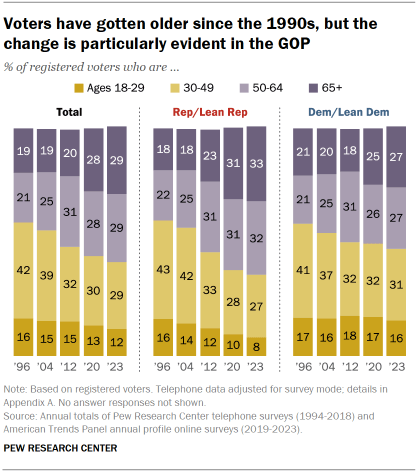
Reflecting this broader change, both parties’ voters are significantly older now than they were 20 years ago. But today Republican and Republican-leaning voters tend to be older than voters in the Democratic coalition. (In 1996, there was very little difference between the age profiles of the two parties.)
- About two-thirds of voters who align with the Republican Party are 50 and older (32% are 50 to 64 and 33% are 65-plus), compared with slightly more than half of those who associate with the Democratic Party (27% each for ages 50 to 64 and those 65 and older). The share of voters under 30 is twice as large among Democrats (16%) than Republicans (8%). A similar share in each party falls between the ages of 30 and 49 (27% among the Republican Party and 31% among the Democratic Party).
Education
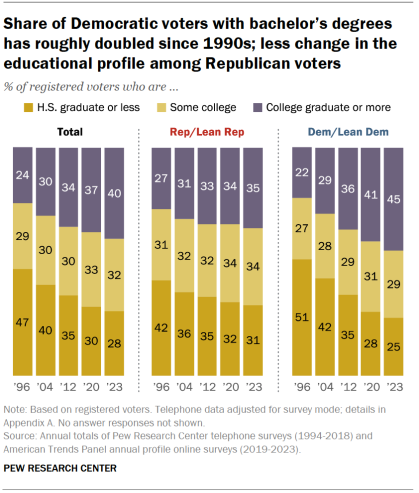
The share of voters with a bachelor’s degree or more has increased significantly among registered voters since 1996, from about a quarter (24%) to four-in-ten today.
Voters with a high school degree or less education have declined roughly in parallel, so that now about three-in-ten have a high school degree or less (28%), compared with nearly half (47%) in 1996. The share of voters with some college experience but no bachelor’s degree has remained relatively stable across this period (32% today, 29% in 1996).
- Among voters who associate with the Democratic Party, the share of voters with a college degree or more has approximately doubled since 1996, from 22% to 45% now. The share of Democratic voters who have no college experience has fallen by about half (from 51% to 25%).
- The Republican coalition has also become more educated, but much more modestly. Today, the GOP’s supporters are divided about equally between those who never went to college (31%), those who attended college but didn’t receive a bachelor’s degree (34%) and those who have a bachelor’s degree or more (35%).
Education by race and ethnicity
The dual trends of increasing education levels and increasing racial and ethnic diversity over the last three decades have resulted in dramatic changes to the electoral landscape.
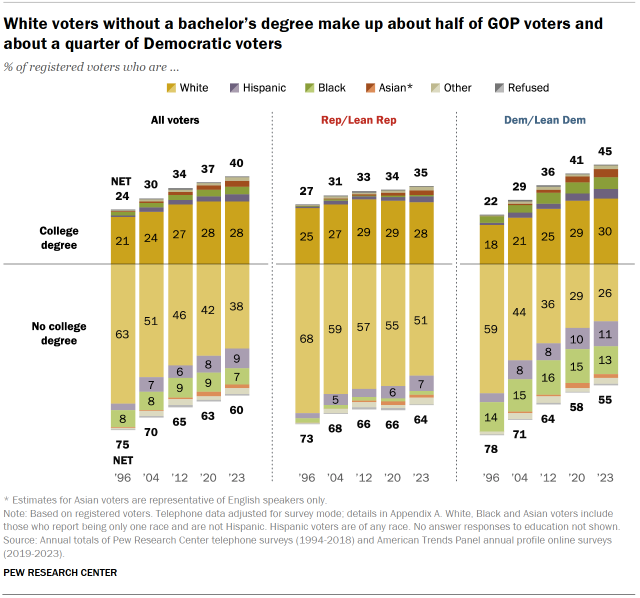
White voters without a bachelor’s degree remain the largest single group of voters across education levels, race and ethnicity. But where they once represented a clear majority (63%) in 1996, they are now about four-in-ten voters overall (38%).
Overall, about two-in-ten voters are Hispanic (9%), Black (7%) or Asian (2%) and without a bachelor’s degree.
Non-Hispanic White adults with a bachelor’s degree or more represent 28% of voters today, which is up modestly since 1996 (21%). Approximately one-in-ten registered voters are Hispanic (3%), Black (3%) or Asian (3%) and have bachelor’s degrees.
The Republican Party
- White voters without a college degree remain the largest bloc within the Republican coalition, but their share has fallen by 17 percentage points since 1996 (from 68% to 51%).
- 28% of those who associate with the GOP are White voters with a bachelor’s degree, roughly on par with the 25% who were White college graduates in 1996.
- 7% of Republican and Republican-leaning voters are Hispanic without a degree, up from 2% in 1996. Another 3% are Hispanic with a degree (1% in 1996).
The Democratic Party
The Democratic Party does not have a single dominant bloc of voters across education levels, race and ethnicity.
- Three-in-ten voters in the Democratic coalition are White with a bachelor’s degree, up from 18% in 1996.
- About a quarter are White voters without a degree (26%). In 1996, this group made up a majority (59%) of Democratic and Democratic-leaning voters.
- Black voters who do not have a bachelor’s degree make up 13% of the Democratic coalition today, nearly identical to the 14% in 1996, while 5% of Democratic voters are Black college graduates (3% in 1996)
- Hispanic voters without a college degree constitute 11% of Democratically aligned voters today (up from 4% in 1996), while Hispanic voters with a degree are 4% of the coalition (1% in 1996).
- 4% of voters who affiliate with or lean to the Democrats are Asian voters with a bachelor’s degree, and 2% are Asian voters without a degree (in 1996, Asian voters overall made up no more than 1% of all Democratic voters).
Religious affiliation
Americans have become less Christian and less religious in recent decades, and the electorate reflects those changes. Two-thirds of voters identify with a Christian denomination, while about a quarter say they are religiously unaffiliated (26%). Fifteen years ago, about eight-in-ten voters were Christians (79%) and 15% were unaffiliated. (We used different questions about religious affiliation prior to 2008, so comparable data only goes back 15 years.)
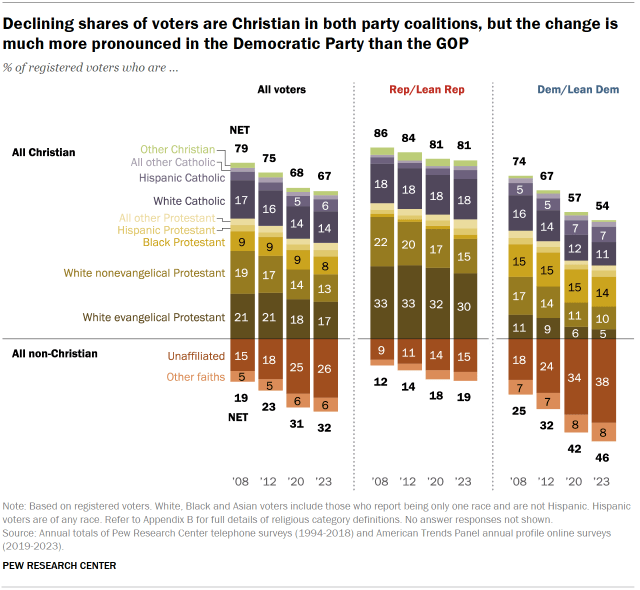
These broader trends of declining shares of Christians and increasing shares of religious “nones” have impacted the demographic composition of the two parties’ coalitions in diverging ways.
- The Republican coalition remains overwhelmingly Christian. About eight-in-ten Republican and Republican-leaning voters (81%) identify with a Christian religious denomination, which is down modestly from 2008 when 86% identified as Christian.
Among GOP voters, the shares who identify as White evangelical Protestants (30% now, 33% in 2008) and White Catholics (18% now and in 2008) are little changed over the past 15 years. White nonevangelical Protestants have declined as a share of Republican and Republican-leaning voters from 22% to 15% over the same period, while religious “nones” have grown from 9% to 15% of GOP voters.
- About half of voters in the Democratic coalition are Christian (54%), while 38% are religiously unaffiliated and 8% are of non-Christian faiths. As recently as 2008, Christians made up 74% of Democratically oriented registered voters. Over this time period, the share of religiously unaffiliated voters in the coalition has roughly doubled.
Today, White evangelical (5%) and White nonevangelical Protestants (10%) are 15% of the Democratic coalition, down from 28% 15 years ago. The share of Democratically aligned voters who are Black Protestants has changed very little over this period (15% then to 14% now).
Ideological composition of voters
The electorate continues to have more voters who call themselves conservative than call themselves liberal. About a quarter of voters say they are liberal (16%) or very liberal (8%), while 37% say they are conservative (26%) or very conservative (10%).
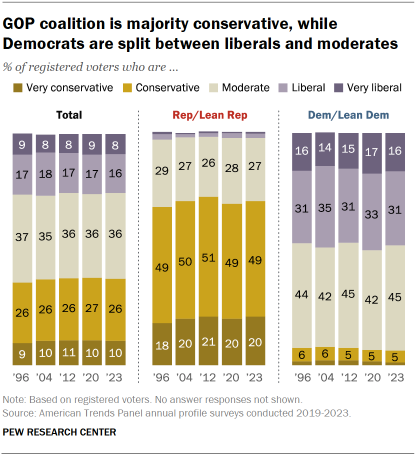
Almost four-in-ten voters say they are moderate (36%).
These shares are little changed since 2019.
The Republican coalition is overwhelmingly conservative: 49% of Republican-aligned voters say they are conservative and 20% say they are very conservative. About three-in-ten GOP voters say they are moderate (27%), and there are very few liberal identifiers in the party (less than 5%).
The Democratic coalition is more ideologically mixed than the Republican coalition. Among voters who associate with the Democrats, about half say they are very liberal (16%) or liberal (31%), while nearly as many say they are moderate (45%). Around 6% say they are conservative.

